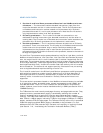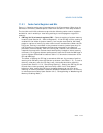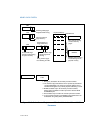
Vol. 3 11-13
MEMORY CACHE CONTROL
large data structure should be marked as uncacheable, or reading it will evict cached
lines that the processor will be referencing again.
A similar example would be a write-only data structure that is written to (to export
the data to another agent), but never read by software. Such a structure can be
marked as uncacheable, because software never reads the values that it writes
(though as uncacheable memory, it will be written using partial writes, while as
write-back memory, it will be written using line writes, which may not occur until the
other agent reads the structure and triggers implicit write-backs).
On the Pentium III, Pentium 4, and more recent processors, new instructions are
provided that give software greater control over the caching, prefetching, and the
write-back characteristics of data. These instructions allow software to use weakly
ordered or processor ordered memory types to improve processor performance, but
when necessary to force strong ordering on memory reads and/or writes. They also
allow software greater control over the caching of data. For a description of these
instructions and there intended use, see
Section 11.5.5, “Cache Management
Instructions.”
11.3.3 Code Fetches in Uncacheable Memory
Programs may execute code from uncacheable (UC) memory, but the implications
are different from accessing data in UC memory. When doing code fetches, the
processor never transitions from cacheable code to UC code speculatively. It also
never speculatively fetches branch targets that result in UC code.
The processor may fetch the same UC cache line multiple times in order to decode an
instruction once. It may decode consecutive UC instructions in a cacheline without
fetching between each instruction. It may also fetch additional cachelines from the
same or a consecutive 4-KByte page in order to decode one non-speculative UC
instruction (this can be true even when the instruction is contained fully in one line).
Because of the above and because cacheline sizes may change in future processors,
software should avoid placing memory-mapped I/O with read side effects in the
same page or in a subsequent page used to execute UC code.
11.4 CACHE CONTROL PROTOCOL
The following section describes the cache control protocol currently defined for the
Intel 64 and IA-32 architectures.
In the L1 data cache and in the L2/L3 unified caches, the MESI (modified, exclusive,
shared, invalid) cache protocol maintains consistency with caches of other proces-
sors. The L1 data cache and the L2/L3 unified caches have two MESI status flags per
cache line. Each line can be marked as being in one of the states defined in
Table
11-4. In general, the operation of the MESI protocol is transparent to programs.


















